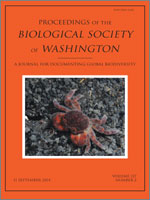A new genus and species of pinnotherid crab, Laminapinnixa miamiensis, is described based on specimens mostly collected from sipunculan burrows in intertidal sand flats on Virginia Key, Miami, Florida. Males of this crab are characterized particularly by the presence of a conspicuous, broad, flattened, ventral abdominal appendage, herein referred to as the “abdominal plate” (AP). This structure has not previously been reported from brachyurans and occurs in males of all sizes (measured by carapace width, CW). Among 89 males and 87 females recovered, 50 crabs (24 males, 26 females) were associated with burrows of Sipunculus nudus Linnaeus, 1766. Hosts of most other specimens were not determined, but it is suggested that many were also likely associated with sipunculans. Eighteen sipunculan burrows had solitary crabs, whereas 15 had more than one; 14 of the 15 had heterosexual pairs. Carapace width (CW) and carapace length (CL) for males were 2.5 to 6.6 mm ( = 4.5 ± 1.0 mm) and 1.3 to 3.4 mm (
= 4.5 ± 1.0 mm) and 1.3 to 3.4 mm ( = 2.4 ± 0.5 mm), respectively; females ranged from 2.3 to 7.8 mm (
= 2.4 ± 0.5 mm), respectively; females ranged from 2.3 to 7.8 mm ( = 4.9 ± 1.3 mm) and 1.3 to 3.9 mm (
= 4.9 ± 1.3 mm) and 1.3 to 3.9 mm ( = 2.5 ± 0.6 mm). Abdominal width (AW) was positively correlated with CW, isometric in males and positively allometric in females. Ovigerous crabs (CW range 5.1 to 7.2 mm;
= 2.5 ± 0.6 mm). Abdominal width (AW) was positively correlated with CW, isometric in males and positively allometric in females. Ovigerous crabs (CW range 5.1 to 7.2 mm;  = 6.3 ± 0.8 mm) were found in April, possibly indicating the beginning of their reproductive season. Multiple broods are produced in isolated females, utilizing sperm remaining in their seminal receptacles. Zoeae hatched in 22 and 23 days in two broods produced by two crabs in the laboratory. Females mature at ∼ 4.5 mm CW. Percent molt increment and intermolt time were negatively and positively correlated with CW, respectively. Crabs in the laboratory entered burrow openings of sipunculans, attached to their posterior ends and were carried through the sand by the worms. A discussion of the suspected function of the abdominal plate and its presence in other pinnotherid species is provided.
= 6.3 ± 0.8 mm) were found in April, possibly indicating the beginning of their reproductive season. Multiple broods are produced in isolated females, utilizing sperm remaining in their seminal receptacles. Zoeae hatched in 22 and 23 days in two broods produced by two crabs in the laboratory. Females mature at ∼ 4.5 mm CW. Percent molt increment and intermolt time were negatively and positively correlated with CW, respectively. Crabs in the laboratory entered burrow openings of sipunculans, attached to their posterior ends and were carried through the sand by the worms. A discussion of the suspected function of the abdominal plate and its presence in other pinnotherid species is provided.
How to translate text using browser tools
1 September 2014
A new genus and species of pinnotherid crab (Decapoda: Brachyura: Pinnotheridae: Pinnothereliinae) with a unique male abdominal appendage, and its symbiotic relationship with a sipunculan worm (Sipuncula) from Miami, Florida, U.S.A.
John J. McDermott
ACCESS THE FULL ARTICLE
It is not available for individual sale.
This article is only available to subscribers.
It is not available for individual sale.
It is not available for individual sale.
abdominal plate
Brachyura
Decapoda
Florida
Pinnotheridae
Sipuncula
symbiosis





